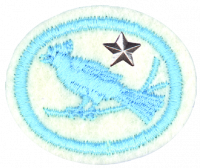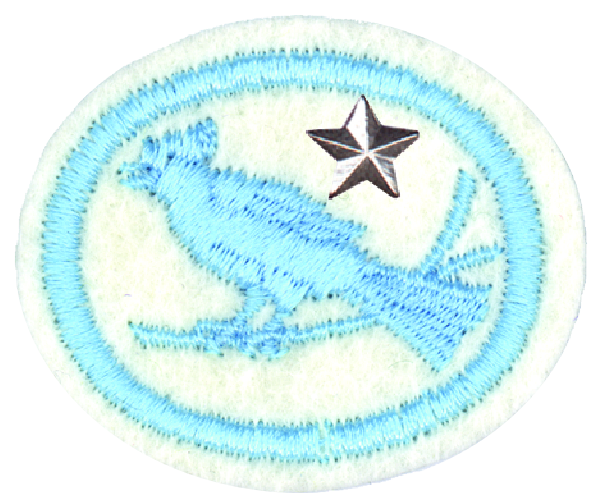Difference between revisions of "AY Honors/Birds - Advanced/Requirements"
Jomegat bot (talk | contribs) m (Add RequirementsHeader) |
m (- Category of Honor Requirements) |
||
| (12 intermediate revisions by 3 users not shown) | |||
| Line 1: | Line 1: | ||
| − | + | {{HonorSubpage}} | |
| + | |||
| + | <section begin=Body /> | ||
| + | |||
| + | <b>1. <section begin=req1 /><noinclude><translate><!--T:1--> | ||
| + | </noinclude>Have the Birds honor. | ||
| + | <noinclude></translate></noinclude><section end=req1 /></b> | ||
| + | |||
| + | <b>2. <section begin=req2 /><noinclude><translate><!--T:2--> | ||
| + | </noinclude>Know the laws protecting birds in your state, province, or country. | ||
| + | <noinclude></translate></noinclude><section end=req2 /></b> | ||
| + | |||
| + | <b>3. <section begin=req3 /><noinclude><translate><!--T:3--> | ||
| + | </noinclude>Describe a bird accurately by using standard names for each part of its body. | ||
| + | <noinclude></translate></noinclude><section end=req3 /></b> | ||
| + | |||
| + | <b>4. <section begin=req4 /><noinclude><translate><!--T:4--> | ||
| + | </noinclude>Find answers to either a. OR b. | ||
| + | <noinclude></translate></noinclude><section end=req4 /></b> | ||
| + | |||
| + | :<b>a. <section begin=req4a /><noinclude><translate><!--T:5--> | ||
| + | </noinclude>In what ways are the feet, legs, and beak of birds variously modified to adapt them to their environment? | ||
| + | <noinclude></translate></noinclude><section end=req4a /></b> | ||
| + | |||
| + | :<b>b. <section begin=req4b /><noinclude><translate><!--T:6--> | ||
| + | </noinclude>On hummingbirds: | ||
| + | <noinclude></translate></noinclude><section end=req4b /></b> | ||
| + | |||
| + | ::<b>i. <section begin=req4bi /><noinclude><translate><!--T:7--> | ||
| + | </noinclude>What do hummingbirds eat in the wild and how often? | ||
| + | <noinclude></translate></noinclude><section end=req4bi /></b> | ||
| + | |||
| + | ::<b>ii. <section begin=req4bii /><noinclude><translate><!--T:8--> | ||
| + | </noinclude>Why aren't hummingbirds afraid of large mammals or birds? | ||
| + | <noinclude></translate></noinclude><section end=req4bii /></b> | ||
| + | |||
| + | ::<b>iii. <section begin=req4biii /><noinclude><translate><!--T:9--> | ||
| + | </noinclude>How do their wings move differently from other birds? | ||
| + | <noinclude></translate></noinclude><section end=req4biii /></b> | ||
| + | |||
| + | ::<b>iv. <section begin=req4biv /><noinclude><translate><!--T:10--> | ||
| + | </noinclude>How fast do they fly? | ||
| + | <noinclude></translate></noinclude><section end=req4biv /></b> | ||
| + | |||
| + | ::<b>v. <section begin=req4bv /><noinclude><translate><!--T:11--> | ||
| + | </noinclude>How fast do the wings and heart beat? | ||
| + | <noinclude></translate></noinclude><section end=req4bv /></b> | ||
| + | |||
| + | ::<b>vi. <section begin=req4bvi /><noinclude><translate><!--T:12--> | ||
| + | </noinclude>How is the tongue shaped? | ||
| + | <noinclude></translate></noinclude><section end=req4bvi /></b> | ||
| + | |||
| + | <b>5. <section begin=req5 /><noinclude><translate><!--T:13--> | ||
| + | </noinclude>Identify on a bird's wing the primaries, secondaries, coverts, axillars, and alulae. | ||
| + | <noinclude></translate></noinclude><section end=req5 /></b> | ||
| + | |||
| + | <b>6. <section begin=req6 /><noinclude><translate><!--T:14--> | ||
| + | </noinclude>Describe the functions and purposes of bird banding, telling in particular how banding contributes to our knowledge about bird movements. | ||
| + | <noinclude></translate></noinclude><section end=req6 /></b> | ||
| + | |||
| + | <b>7. <section begin=req7 /><noinclude><translate><!--T:15--> | ||
| + | </noinclude>Name the main migratory bird flyways used by birds in your continent. | ||
| + | <noinclude></translate></noinclude><section end=req7 /></b> | ||
| + | |||
| + | <b>8. <section begin=req8 /><noinclude><translate><!--T:16--> | ||
| + | </noinclude>Give the migration routes and terminal destinations for ten different migratory bird species. | ||
| + | <noinclude></translate></noinclude><section end=req8 /></b> | ||
| + | |||
| + | <b>9. <section begin=req9 /><noinclude><translate><!--T:17--> | ||
| + | </noinclude>Describe at least three different ways that birds are able to orient themselves in their movements across the globe. | ||
| + | <noinclude></translate></noinclude><section end=req9 /></b> | ||
| + | |||
| + | <section begin=challenge /> | ||
| + | <b>10. <section begin=req10 /><noinclude><translate><!--T:18--> | ||
| + | </noinclude>Make a list of 60 species of wild birds, including birds from at least ten different families, that you personally have observed and positively identified by sight out of doors. For each species on this list note the following: | ||
| + | :a. Name | ||
| + | :b. Date observed | ||
| + | :c. Place observed | ||
| + | :d. Habitat (i.e., field, woods, river, lake, etc.) | ||
| + | :e. Status where observed (permanent resident, winter resident, summer resident, migrant, vagrant) | ||
| + | <noinclude></translate></noinclude><section end=req10 /></b> | ||
| + | <section end=challenge /> | ||
| + | |||
| + | <b>11. <section begin=req11 /><noinclude><translate><!--T:19--> | ||
| + | </noinclude>Present lists of birds, showing the greatest number of species seen out of doors in: | ||
| + | :a. One day (with at least six hours in the field) | ||
| + | :b. One week | ||
| + | :c. Your lifetime (all birds observed by you since you began birding to date) | ||
| + | <noinclude></translate></noinclude><section end=req11 /></b> | ||
| + | |||
| + | <b>12. <section begin=req12 /><noinclude><translate><!--T:20--> | ||
| + | </noinclude>Make a list of ten species of wild birds that you personally have positively identified by sound out of doors, and describe or imitate these bird sounds as best you can. | ||
| + | <noinclude></translate></noinclude><section end=req12 /></b> | ||
| + | |||
| + | <b>13. <section begin=req13 /><noinclude><translate><!--T:21--> | ||
| + | </noinclude>Lead a group in a bird observation walk or tell two Bible stories in which a bird was significant. | ||
| + | <noinclude></translate></noinclude><section end=req13 /></b> | ||
| + | <section end=Body /> | ||
Latest revision as of 20:48, 20 July 2022
1. Have the Birds honor.
2. Know the laws protecting birds in your state, province, or country.
3. Describe a bird accurately by using standard names for each part of its body.
4. Find answers to either a. OR b.
- a. In what ways are the feet, legs, and beak of birds variously modified to adapt them to their environment?
- b. On hummingbirds:
- i. What do hummingbirds eat in the wild and how often?
- ii. Why aren't hummingbirds afraid of large mammals or birds?
- iii. How do their wings move differently from other birds?
- iv. How fast do they fly?
- v. How fast do the wings and heart beat?
- vi. How is the tongue shaped?
5. Identify on a bird's wing the primaries, secondaries, coverts, axillars, and alulae.
6. Describe the functions and purposes of bird banding, telling in particular how banding contributes to our knowledge about bird movements.
7. Name the main migratory bird flyways used by birds in your continent.
8. Give the migration routes and terminal destinations for ten different migratory bird species.
9. Describe at least three different ways that birds are able to orient themselves in their movements across the globe.
10. Make a list of 60 species of wild birds, including birds from at least ten different families, that you personally have observed and positively identified by sight out of doors. For each species on this list note the following:
- a. Name
- b. Date observed
- c. Place observed
- d. Habitat (i.e., field, woods, river, lake, etc.)
- e. Status where observed (permanent resident, winter resident, summer resident, migrant, vagrant)
11. Present lists of birds, showing the greatest number of species seen out of doors in:
- a. One day (with at least six hours in the field)
- b. One week
- c. Your lifetime (all birds observed by you since you began birding to date)
12. Make a list of ten species of wild birds that you personally have positively identified by sound out of doors, and describe or imitate these bird sounds as best you can.
13. Lead a group in a bird observation walk or tell two Bible stories in which a bird was significant.


